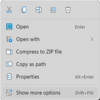I upgraded my mother board to a Asus Rog Strix Z690-A Gaming WiFi D4. Bitlocker is turned off. (Has never been turned on). How to I get the bitlocker key. It's not on my Microsoft Account. Does it have to be turned on to record the Bitlocker key?
My Computers
System One System Two
-
- OS
- Windows 11 Home
- Computer type
- Laptop
- Manufacturer/Model
- Asus GU6903H
- CPU
- 11th Gen Intel Core i9-11900H@ 2.50 GHZ
- Memory
- 16 gig
- Graphics Card(s)
- NVIDIA® GeForce RTX™ 3060 Laptop GPU
- Monitor(s) Displays
- 16 In
-
- Operating System
- Windows 11 Pro
- Computer type
- PC/Desktop
- Manufacturer/Model
- Custom
- CPU
- 12th Gen Intel Core i9-12900k 3.20 GHz
- Motherboard
- Asus Rog Strix Z690-A Gaming WiFi D4
- Memory
- 64 GB

















